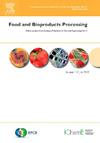冷冻、喷雾和真空干燥荠菜蛋白粉及其理化和功能特性
IF 3.5
2区 农林科学
Q2 BIOTECHNOLOGY & APPLIED MICROBIOLOGY
引用次数: 0
摘要
本研究旨在探讨不同干燥方法对荠菜蛋白质理化和功能特性的影响。采用碱提取和等电沉淀法提取荠菜蛋白,然后通过冷冻干燥、喷雾干燥和真空干燥进行干燥。荠菜蛋白粉的蛋白质含量介于 62.5 至 64.1 克/100 克(干基)之间。谷氨酸是喷雾干燥和真空干燥蛋白质中最主要的氨基酸,而脯氨酸是冷冻干燥荠菜蛋白质中最主要的氨基酸。荠菜蛋白质的变性峰值温度在 100.5 至 104.3 ℃ 之间。冻干荠菜蛋白质的表面疏水性(5.8 µg/mg)低于其他蛋白质(9.1-19.1 µg/mg)。在荠菜蛋白中,喷雾干燥蛋白的持水量(2.9 g/g)、乳化活性(0.53 mL/mL)和稳定性(0.96 mL/mL)以及发泡能力(0.48 mL/mL)和稳定性(0.92 mL/mL)都是最高的。此外,喷雾干燥的荠菜蛋白在较低的浓度(10%)下也能形成凝胶。因此,采用不同干燥方法生产的荠菜蛋白粉具有不同的理化和功能特性。本文章由计算机程序翻译,如有差异,请以英文原文为准。
Freeze, spray, and vacuum dried Camelina sativa protein powders and their physicochemical and functional properties
The objective of this study was to examine the effect of different drying methods on the physicochemical and functional properties of camelina protein. Camelina protein was extracted using the alkaline extraction and isoelectric precipitation method and subsequently dried by freeze, spray, and vacuum-drying. The protein contents of camelina protein powders ranged between 62.5 and 64.1 g/100 g (dry basis). Glutamic acid was the most dominant amino acid for spray-dried and vacuum-dried proteins, while proline was for freeze-dried camelina protein. Camelina proteins had a peak denaturation temperature between 100.5 and 104.3 °C. The surface hydrophobicity of freeze-dried camelina protein (5.8 µg/mg) was lower than others (9.1–19.1 µg/mg). The spray-dried protein showed the highest water-holding capacity (2.9 g/g), emulsion activity (0.53 mL/mL) and stability (0.96 mL/mL), as well as foaming capacity (0.48 mL/mL) and stability (0.92 mL/mL) among camelina proteins. Moreover, spray-dried camelina protein formed gel at a lower concentration (10 %). Consequently, camelina protein powders produced by different drying methods demonstrated different physicochemical and functional properties.
求助全文
通过发布文献求助,成功后即可免费获取论文全文。
去求助
来源期刊

Food and Bioproducts Processing
工程技术-工程:化工
CiteScore
9.70
自引率
4.30%
发文量
115
审稿时长
24 days
期刊介绍:
Official Journal of the European Federation of Chemical Engineering:
Part C
FBP aims to be the principal international journal for publication of high quality, original papers in the branches of engineering and science dedicated to the safe processing of biological products. It is the only journal to exploit the synergy between biotechnology, bioprocessing and food engineering.
Papers showing how research results can be used in engineering design, and accounts of experimental or theoretical research work bringing new perspectives to established principles, highlighting unsolved problems or indicating directions for future research, are particularly welcome. Contributions that deal with new developments in equipment or processes and that can be given quantitative expression are encouraged. The journal is especially interested in papers that extend the boundaries of food and bioproducts processing.
The journal has a strong emphasis on the interface between engineering and food or bioproducts. Papers that are not likely to be published are those:
• Primarily concerned with food formulation
• That use experimental design techniques to obtain response surfaces but gain little insight from them
• That are empirical and ignore established mechanistic models, e.g., empirical drying curves
• That are primarily concerned about sensory evaluation and colour
• Concern the extraction, encapsulation and/or antioxidant activity of a specific biological material without providing insight that could be applied to a similar but different material,
• Containing only chemical analyses of biological materials.
 求助内容:
求助内容: 应助结果提醒方式:
应助结果提醒方式:


